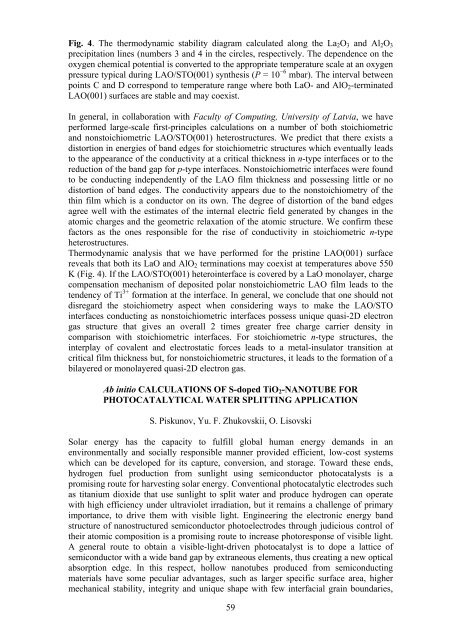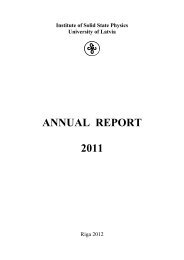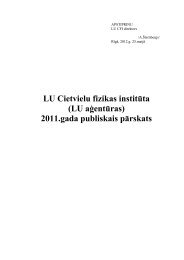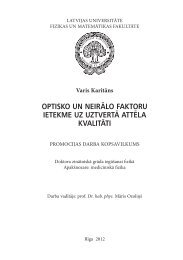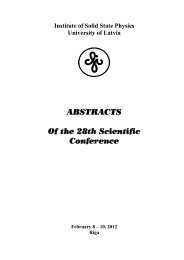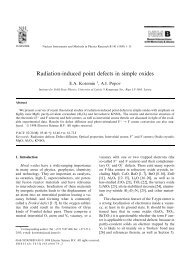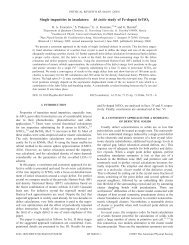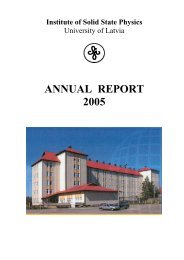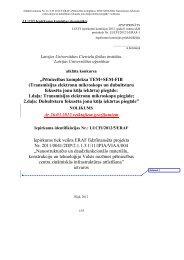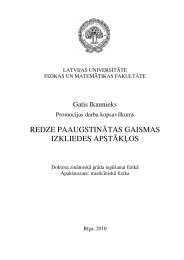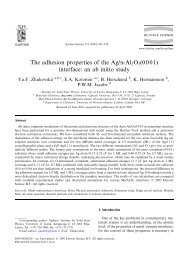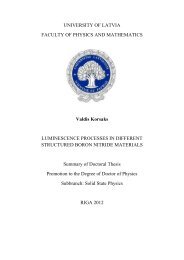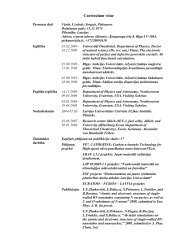Annual Report 2012 - Latvijas Universitātes Cietvielu fizikas institūts
Annual Report 2012 - Latvijas Universitātes Cietvielu fizikas institūts
Annual Report 2012 - Latvijas Universitātes Cietvielu fizikas institūts
Create successful ePaper yourself
Turn your PDF publications into a flip-book with our unique Google optimized e-Paper software.
Fig. 4. The thermodynamic stability diagram calculated along the La 2 O 3 and Al 2 O 3<br />
precipitation lines (numbers 3 and 4 in the circles, respectively. The dependence on the<br />
oxygen chemical potential is converted to the appropriate temperature scale at an oxygen<br />
pressure typical during LAO/STO(001) synthesis (P = 10 −6 mbar). The interval between<br />
points C and D correspond to temperature range where both LaO- and AlO 2 -terminated<br />
LAO(001) surfaces are stable and may coexist.<br />
In general, in collaboration with Faculty of Computing, University of Latvia, we have<br />
performed large-scale first-principles calculations on a number of both stoichiometric<br />
and nonstoichiometric LAO/STO(001) heterostructures. We predict that there exists a<br />
distortion in energies of band edges for stoichiometric structures which eventually leads<br />
to the appearance of the conductivity at a critical thickness in n-type interfaces or to the<br />
reduction of the band gap for p-type interfaces. Nonstoichiometric interfaces were found<br />
to be conducting independently of the LAO film thickness and possessing little or no<br />
distortion of band edges. The conductivity appears due to the nonstoichiometry of the<br />
thin film which is a conductor on its own. The degree of distortion of the band edges<br />
agree well with the estimates of the internal electric field generated by changes in the<br />
atomic charges and the geometric relaxation of the atomic structure. We confirm these<br />
factors as the ones responsible for the rise of conductivity in stoichiometric n-type<br />
heterostructures.<br />
Thermodynamic analysis that we have performed for the pristine LAO(001) surface<br />
reveals that both its LaO and AlO 2 terminations may coexist at temperatures above 550<br />
K (Fig. 4). If the LAO/STO(001) heterointerface is covered by a LaO monolayer, charge<br />
compensation mechanism of deposited polar nonstoichiometric LAO film leads to the<br />
tendency of Ti 3+ formation at the interface. In general, we conclude that one should not<br />
disregard the stoichiometry aspect when considering ways to make the LAO/STO<br />
interfaces conducting as nonstoichiometric interfaces possess unique quasi-2D electron<br />
gas structure that gives an overall 2 times greater free charge carrier density in<br />
comparison with stoichiometric interfaces. For stoichiometric n-type structures, the<br />
interplay of covalent and electrostatic forces leads to a metal-insulator transition at<br />
critical film thickness but, for nonstoichiometric structures, it leads to the formation of a<br />
bilayered or monolayered quasi-2D electron gas.<br />
Ab initio CALCULATIONS OF S-doped TiO 2 -NANOTUBE FOR<br />
PHOTOCATALYTICAL WATER SPLITTING APPLICATION<br />
S. Piskunov, Yu. F. Zhukovskii, O. Lisovski<br />
Solar energy has the capacity to fulfill global human energy demands in an<br />
environmentally and socially responsible manner provided efficient, low-cost systems<br />
which can be developed for its capture, conversion, and storage. Toward these ends,<br />
hydrogen fuel production from sunlight using semiconductor photocatalysts is a<br />
promising route for harvesting solar energy. Conventional photocatalytic electrodes such<br />
as titanium dioxide that use sunlight to split water and produce hydrogen can operate<br />
with high efficiency under ultraviolet irradiation, but it remains a challenge of primary<br />
importance, to drive them with visible light. Engineering the electronic energy band<br />
structure of nanostructured semiconductor photoelectrodes through judicious control of<br />
their atomic composition is a promising route to increase photoresponse of visible light.<br />
A general route to obtain a visible-light-driven photocatalyst is to dope a lattice of<br />
semiconductor with a wide band gap by extraneous elements, thus creating a new optical<br />
absorption edge. In this respect, hollow nanotubes produced from semiconducting<br />
materials have some peculiar advantages, such as larger specific surface area, higher<br />
mechanical stability, integrity and unique shape with few interfacial grain boundaries,<br />
59


